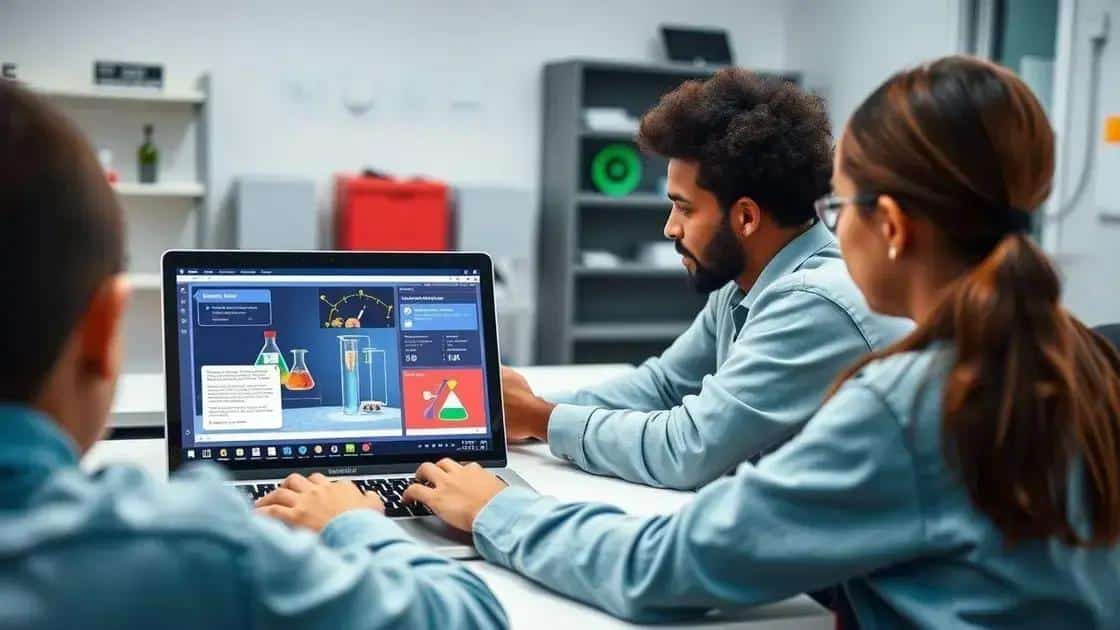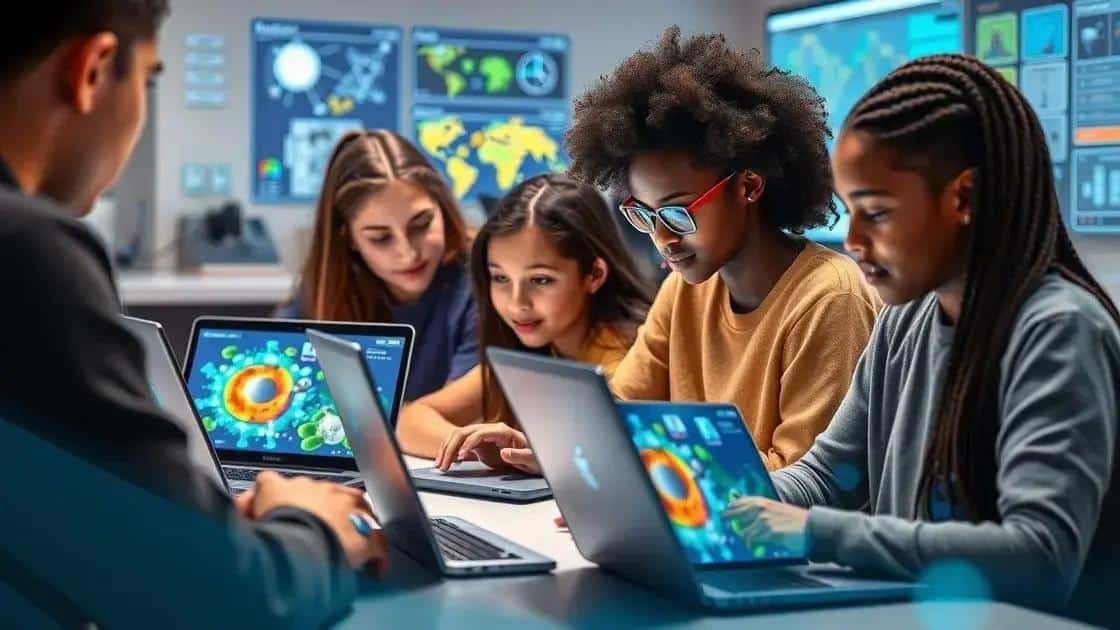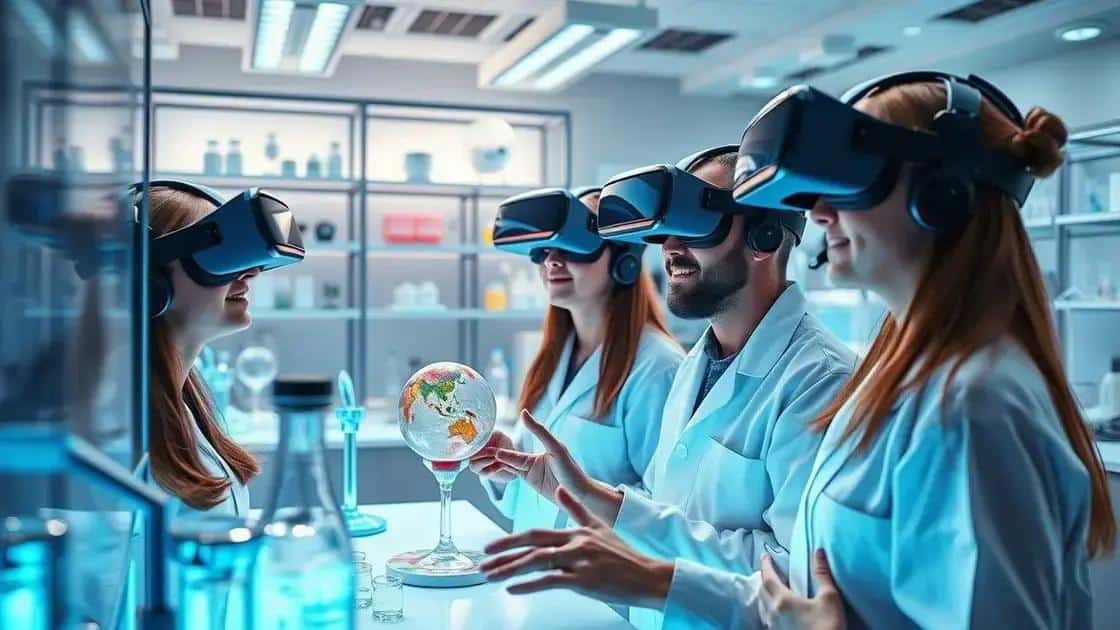Insights on virtual lab simulations for effective learning

Virtual lab simulations enhance education by providing immersive, interactive experiences that boost student engagement, improve accessibility, and enable collaboration and personalized learning through advanced technologies like VR and AI.
Insights on virtual lab simulations show how these tools transform traditional learning into an immersive experience. Have you ever wondered how students can safely experiment without the risks? Let’s dive into this fascinating topic.
Understanding virtual lab simulations
Understanding virtual lab simulations is essential for educators and students alike. These simulations provide a unique opportunity to engage with complex concepts in a safe environment. They blend theoretical knowledge with practical application, allowing learners to experiment and discover without the risks associated with physical labs.
What are virtual lab simulations?
Virtual lab simulations are computer-based environments that replicate real-world laboratory experiences. Students can manipulate variables, conduct experiments, and observe outcomes just as they would in a traditional lab setting. These tools are becoming increasingly popular in STEM education, where hands-on experience is crucial.
Benefits of virtual lab simulations
There are several advantages to using virtual lab simulations in education. The key benefits include:
- Accessibility: Students can access labs from anywhere, making science education more inclusive.
- Cost-effectiveness: Virtual labs eliminate the need for physical materials and equipment, reducing costs.
- Safety: Dangerous experiments can be conducted without risk to students.
- Immediate feedback: Learners receive real-time results, enhancing the learning process.
By providing an interactive platform, virtual lab simulations also promote engagement. Students often find these simulations more entertaining than traditional methods, which can lead to better retention of information. Furthermore, the ability to practice repeatedly without the constraints of time or resources means that students can solidify their understanding of challenging content.
In conclusion, embracing virtual lab simulations is a step forward in modern education. These innovative tools create a dynamic learning environment, encouraging exploration and critical thinking among students.
Benefits of using virtual labs in education

The benefits of using virtual labs in education are vast and impactful. These innovative tools allow students to engage with scientific concepts in a way that traditional methods may not. By providing interactive experiences, virtual labs enhance understanding and retention of key ideas.
Increased accessibility
One of the most significant advantages is the increased accessibility to learning. Students can participate in lab activities anytime, anywhere. This flexibility makes it easier for learners to fit science experiments into their schedules, ensuring they don’t miss out on critical hands-on learning experiences.
Cost savings
Cost is another crucial factor. Virtual labs eliminate the need for physical materials that can be expensive and limited. Schools can save on equipment, maintenance, and supplies, directing funds toward other educational resources. This makes science more approachable for institutions with tight budgets.
Enhanced safety
Safety is a top concern in traditional labs, especially with hazardous materials. Virtual labs create a risk-free environment where students can conduct experiments without fear of injury. They can explore dangerous reactions and volatile experiments without any danger, promoting a more confident learning experience.
The excitement of experimentation can also be preserved in these simulations. Students often find virtual environments engaging and fun. This level of engagement can stimulate curiosity and encourage exploration that might not happen in a traditional classroom setting. Real-time feedback during virtual lab sessions helps students learn from their mistakes instantly, fostering a deeper understanding of the subject matter.
Furthermore, virtual labs support diverse learning styles. Visual learners can benefit from interactive simulations, while analytical thinkers can dig into data and results. This adaptability allows educators to cater to a wide range of students’ needs, promoting inclusive education.
How virtual labs improve engagement
Virtual labs have a unique ability to improve student engagement significantly. Unlike traditional classrooms, these interactive environments allow learners to immerse themselves in real-world scenarios. Through simulations, students can visualize complex concepts, making learning more relatable and engaging.
Interactive learning experiences
One of the main reasons virtual labs boost engagement is the emphasis on interactive learning. Students can manipulate variables and see real-time results, which fosters a deeper understanding of scientific principles. This hands-on approach encourages curiosity, which is essential for effective learning.
Gamification of learning
Many virtual labs use gamification techniques that make learning feel like a game. This not only makes education enjoyable but also motivates students to strive for achievements. Features like challenges, rewards, and levels can keep learners invested and excited about their studies.
Collaboration opportunities
Virtual labs also create opportunities for collaboration among students. They can work together on experiments, share data, and solve problems collectively. This enhances teamwork skills and encourages students to communicate effectively, which is vital in today’s interconnected world.
Moreover, the feedback provided in virtual labs is immediate, which enhances the learning experience. When students get instant results after making adjustments in their simulations, they can quickly understand what worked and what didn’t, reinforcing their learning process. This instant feedback loop helps maintain interest and keeps learners engaged.
By offering a safe space to experiment without the fear of failure, virtual labs help build confidence in students. As they explore and discover through these simulations, their engagement naturally increases, leading to better educational outcomes. This spark of excitement can transform students into active participants in their own learning journey.
Future trends in virtual laboratory technology

The future trends in virtual laboratory technology promise to revolutionize education even further. As technology continues to advance, so do the capabilities of virtual labs. These innovations aim to create immersive, highly interactive experiences that attract and retain students’ attention more effectively.
Enhanced realism with virtual reality
One significant trend is the integration of virtual reality (VR). This technology allows students to step inside a virtual lab, interacting with 3D models and simulations as if they were in a physical space. Such experiences can provide deeper engagement and understanding of complex scientific concepts.
Artificial Intelligence customization
Another promising development is the use of artificial intelligence (AI) to personalize the learning experience. AI can analyze students’ interactions and performance, offering customized feedback and adapting challenges to suit individual learning paces. This means that each student receives a tailored educational experience that meets their unique needs.
Collaboration in a global environment
Future virtual labs will also enhance collaboration among students from around the world. With interconnected platforms, learners can work together on experiments in real-time, sharing data and insights despite being miles apart. This fosters a global perspective and teamwork skills that are vital in today’s world.
Additionally, the use of cloud technology will enable students to access labs from various devices, making learning flexible. No longer confined to desktop computers, learners will participate from tablets and smartphones, providing accessibility like never before.
As more institutions adopt these advanced virtual lab technologies, we can expect a shift in educational practices. By integrating these tools into curriculums, educators can provide engaging, hands-on experiences that would otherwise be impossible due to resource constraints.
FAQ – Frequently Asked Questions about Virtual Lab Simulations
What are virtual lab simulations?
Virtual lab simulations are computer-based tools that replicate real laboratory experiences, allowing students to conduct experiments safely and interactively.
How do virtual labs enhance student engagement?
These labs provide interactive and immersive experiences that make learning exciting, helping to maintain students’ interest and motivation.
What technologies are integrated into virtual labs?
Virtual labs often incorporate technologies like virtual reality and artificial intelligence to create more realistic and personalized learning experiences.
Can virtual labs facilitate collaboration among students?
Yes, virtual labs allow students to collaborate in real-time from different locations, encouraging teamwork and global learning opportunities.





